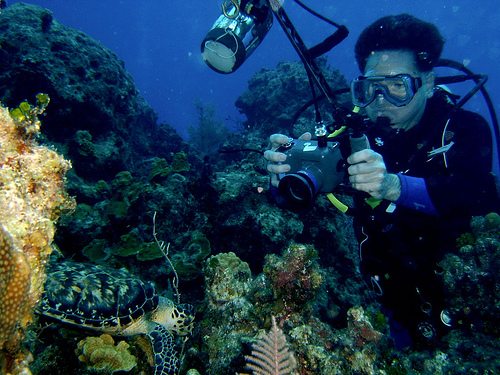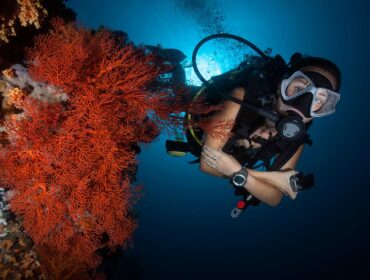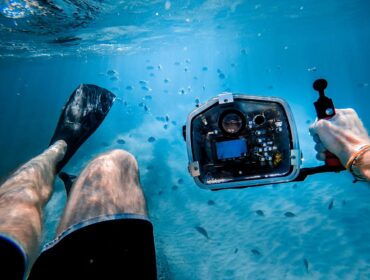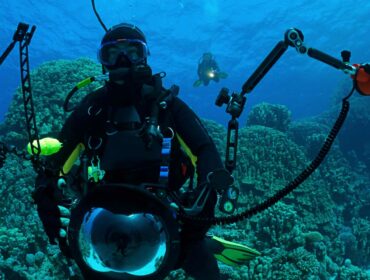Poor diving etiquette from fellow divers is one of things that can completely ruin a dive, no matter how great the dive site and diving conditions. Apart from those faux pas that come from inexperience which are somewhat excusable, divers have to maintain the common courtesies and basic scuba etiquette when diving in groups, both on the dive boat and in the water (Read: Dive Boat Etiquette- For Pro’s and Rookies Alike).
Often divers and underwater photographers get so involved in the pursuit of getting underwater pictures that they become oblivious to those around them, much to the annoyance of other divers. Having an underwater camera in your hand doesn’t warrant special treatment or give anyone an excuse to behave obnoxiously towards other divers in anyway. Monopolizing the dive deck, muscling fellow divers out of the way whenever you see something interesting to photograph and touching coral yourself or with your photography equipment are not only pet peeves for other divers but are also inexcusably wrong.
Here’s a few codes of conduct to to remember as an Underwater Photographer:
On the Dive Boat…
- When staging your camera gear onboard, while yes, it’s important that your photography gear is kept in a safe location, it shouldn’t be at the inconvenience of others. Be cautious of the extra space your equipment takes and with a little courtesy I’m sure your non-photographer divers onboard will reciprocate with due consideration.
- It’s important when diving from a dive boat, that photographers keep their camera’s set and ready to go well before you reach the dive site. In fact it’s best to assemble all your underwater photography equipment (especially if it’s bulky with a lot of components) before you board so as to avoid fiddling with it on the boat where there’s limited space and a chance of accidentally getting something wet.
- Avoid shuffling along the deck in full gear with you camera in hand when it’s your turn to go. You could maybe ask a deckhand to pass you the camera at the stern once you’re in the water or opt to get in last. Make sure any strobe arms are tightly attached and you tell them how to handle the equipment correctly.
- Usually there’s a separate rinse bin dedicated for cameras, make sure that there is no other cameras in it before dunking your gear for a rinse. Never leave your gear in the rinse bin as it’ll inconvenience other photographers that need to use the fresh water. Be careful of entanglements if there are multiple camera systems in the rinse tank as you could do some serious damage to the equipment.
In the Water…
- Only handle complex or bulky underwater photography gear if you are an experienced diver and you diving skills are up to it. If you don’t have great control over your buoyancy, you shouldn’t be shooting underwater. Carrying a camera system underwater, no matter how heavy or big doesn’t excuse divers from being callous with their surroundings.
- Never and I repeat, NEVER purposely or even unintentionally touch or bump into coral just to get that really good shot. Remember…the environment always comes first. Damaging the underwater environment in pursuit of a photo is the ultimate faux pas for any diver.
- Always take a good look at where you rest your gear or put your feet and hands when finding a good position for a shot. It’s best if you can hover without touching anything. If that’s not possible, you may kneel in a sandy patch or use one finger a rock surface, but not coral! When close to the bottom, avoid kicking up any sand that could ruin visibility for other divers or which could settle on surrounding reef and smother it.
- Removing critters from their homes to create a better background, handling any marine creatures or chasing and harassing fish, are definite No-No’s.
- Having a camera does not trump the dive experience of a non-photographer nor does it allow anyone to hog the most interesting marine life. Allow everyone a fair view of anything of interest and wait from a distance before moving in with your camera gear.
- Avoid swimming near any other photographers setting up a shot so you don’t scare away their subject. Wait till fellow photographers have finished completely with their subject before swooping in to take a shot yourself, not matter how much you are afraid you’ll miss it.
We’re all lucky to get a chance to experience the world underwater like we do, however no one has earned precedence over another. Respect you fellow divers and the environment around you, never abuse this privilege of the experience.






